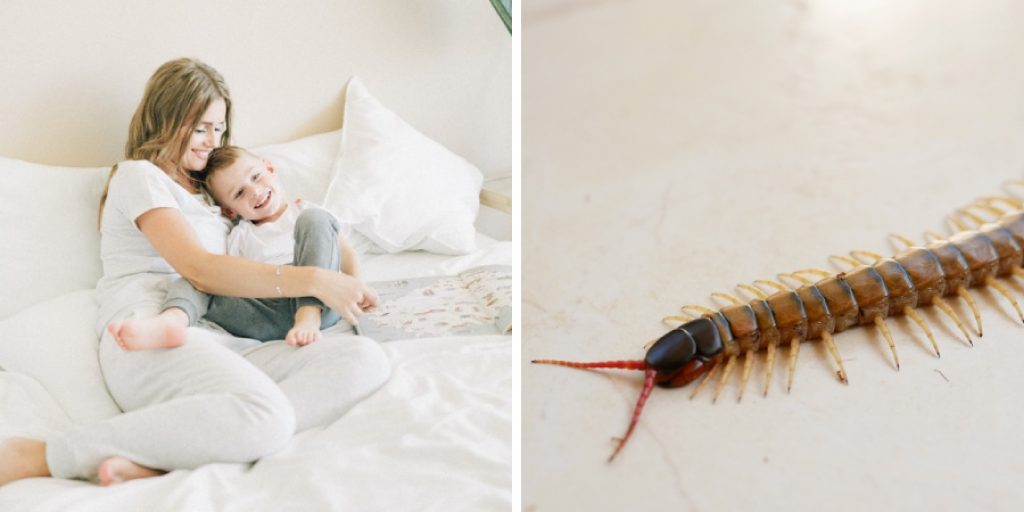How to Keep Centipedes Out of Your Bed
Centipedes can be a nuisance in the home, and their presence may feel particularly concerning if they decide to take up residence in your bed. Centipedes are predatory insects that feed on other household pests like flies, cockroaches, and moths. This makes them beneficial for controlling other insect populations, but it doesn’t make sharing your bed with them any more pleasant.

The primary benefit of keeping centipedes out of your bed is improved health and comfort. Centipedes are predators that feed on other insects, including ones that may be living in your bedroom, such as spiders or cockroaches. Therefore, eliminating their access to your bed, it reduces the chances of being bitten or stung by centipedes. You can find step-by-step instructions on how to keep centipedes out of your bed in this blog article.
How Can You Identify a Centipede in Your Bed?
Identifying a centipede in your bed can be difficult, as they are small and fast-moving. Some common signs of an infestation include bite marks on your skin, especially if you sleep with your arms or legs outside the sheet. Small holes in the mattress may also indicate centipedes have been nesting there. If you suspect a centipede, you should inspect the area carefully to confirm it is not another type of bug.
If your sheets and mattress are infested with centipedes, it may be difficult to get rid of them without professional help. However, you can take steps to prevent a centipede infestation from occurring in the first place. The most important step is keeping your bedroom clean and clutter-free. Centipedes typically hide in the dark, damp places like underneath furniture or in crevices and cracks, so removing any potential hiding spots is important. Vacuuming regularly and keeping all surfaces clean can help discourage centipedes from entering your bed.
Step-by-step Instructions for How to Keep Centipedes Out of Your Bed
Step 1: Inspect the Exterior
Carefully inspect the outside of your home, checking windows and doors for any cracks or other openings. Seal up any holes or gaps you find with caulk to stop centipedes from entering. Centipedes thrive in the dark, moist areas like laundry rooms and basements. Regularly vacuum these areas to reduce the number of centipedes in your home.
Step 2: Remove Clutter

Removing clutter around the house will make it harder for centipedes to find hiding places. Get rid of old boxes, clothes, and other items that may be harboring them. Centipedes need moisture to survive, so reduce any sources of moisture in your home. Fix leaky pipes and use dehumidifiers if necessary.
Step 3: Check for Food Sources
Look for areas where food may be available to centipedes, such as beneath appliances or around pet dishes. Clean up any food crumbs or particles you find to reduce the risk of centipedes infesting your home. Centipedes tend to hide in dark, quiet places, such as beneath furniture and inside closets. Remove these shelters by vacuuming regularly and using a flashlight to check for them.
Step 4: Use Insecticides
If you still have a problem with centipedes, use an insecticide labeled specifically for centipede control. Follow the instructions on the label carefully to ensure proper application and safety. Centipedes dislike the smell of citrus, so try placing pieces of lemon peel around your bed as a natural deterrent.
Step 5: Place Cloves Around Your Bed
Clove oil has been proven to be an effective repellent against centipedes, so place some ground cloves in strategic places like near your bed or along window sills. Introducing natural predators like lizards or frogs into your home can help control the centipede population. They will hunt and eat centipedes, thus reducing their numbers.
Safety Tips for How to Keep Centipedes Out of Your Bed
- Inspect bedding, mattresses, box springs, and other furniture for any signs of centipedes before bringing them into your home.
- Seal all cracks and holes around windows and doors to prevent insects from entering your home.
- Check outdoor areas near the stairwells or decks for any centipedes that may have made their way indoors.
- Regularly vacuum around your bed and all furniture to remove any insects that may have found their way inside.
- Vacuum up any centipede eggs if you find them in or around your bed.
- Use a specially-made insecticide on mattresses, box springs, and other furniture to prevent centipedes from taking up residence in your bed.
- Keep all pet food and water dishes away from your bed, as this could attract insects that centipedes like to feed on.
Following these safety tips, you can ensure that your bedroom remains free of centipedes and insects.
How Can You Prevent Centipedes From Entering Your Bedroom or Bed Space?
Prevention is the best defense against centipedes from entering your bedroom or bed space. Here are some tips that can help:

- Keep Your Home Clean and Free of Clutter: Centipedes like to hide in dark, damp places, such as piles of clothes, boxes, and other debris. Vacuum regularly and store items in plastic containers or bins.
- Seal Off Entry Points: Check all windows, doors, and any other openings for cracks or gaps that centipedes may be able to squeeze through. Use caulk or weatherstripping to seal them off.
- Repair Any Water Damage: Centipedes need moisture to survive, so repairing any leaks or standing water in your home can help prevent an infestation.
- Remove Outdoor Hiding Spots: Trim trees, bushes, and weeds around the exterior of your home to remove centipede hiding places. Make sure your foundation is also free of debris.
By taking these steps, you can help keep centipedes out of your bedroom and bed space. If you find that centipedes are still getting inside, contact a pest control professional for assistance. They can help identify the entry points and provide treatments to remove the infestation.
How Can You Best Clean Your Home to Ensure No Centipedes Remain in Your Bedroom or Bed Space?
The best way to keep centipedes away from your bed is by cleaning your home and making it inhospitable. This includes vacuuming regularly, removing clutter, sealing cracks or openings in walls and floors, fixing leaky faucets and pipes, and reducing moisture. Additionally, you can use insecticides to eliminate any centipedes that may have already infested your home.

When vacuuming, pay particular attention to areas where you think a centipede may be hiding – such as underneath furniture, around baseboards, and in dark corners of the room. Make sure to empty the vacuum cleaner bag or canister after each use so that captured centipedes can’t escape. If you suspect that your bed and bedroom have been infested with centipedes, contact a professional pest control company to help you get rid of them.
They will be able to identify the species of centipede, determine their source, and provide the most effective treatment option. To eliminate the infestation, professional extermination treatments may include insecticide sprays, dust, and baits.
How Often Should You Inspect Your Bed for Signs of Centipede Infestations?
Regularly inspecting your bed for signs of centipedes is a key step in keeping them out. Look closely at the mattress, box springs, and bed frame for any telltale signs of infestation, such as webbing or discarded parts from molting centipedes. Additionally, take time to inspect the area around your bed, too, as centipedes can often find their way in, even if the bed is free of them. Look especially in dark, damp areas such as basements and closets.
If you do spot signs of centipede infestations, take immediate action to get rid of them. Vacuum up any webbing or molted parts left behind and treat the area with an insecticide that is specifically labeled to work against centipedes. Take measures to prevent them from coming back, including sealing any potential entry points into your home and making sure there are no sources of excess moisture or standing water near your bed. Finally, make sure to regularly clean your bedding and vacuum around it in order to keep centipedes away.
Conclusion
One of the biggest disadvantages of trying to keep centipedes out of your bed is that they can be difficult to detect and control. Centipedes are small, making them hard to spot in the dark, and their swift movements make it tough to catch them before they move away from any given area. This can make it difficult for homeowners to identify where centipedes are likely to be hiding and how to target those areas in order to keep them out of bed.

In conclusion, keeping centipedes out of your bed is possible with a few simple steps. Start by creating an environment that does not attract or harbor them, like keeping clutter to a minimum and using products with strong odors like moth balls or cedar chips to repel them. Seal off entry points around your home, inspect for cracks and crevices in the walls and windows, and use caulk or weatherstripping to seal them. If you still have an infestation, contact a professional pest control service for help. I hope this article has been beneficial for learning how to keep centipedes out of your bed. Make Sure the precautionary measures are followed chronologically.




